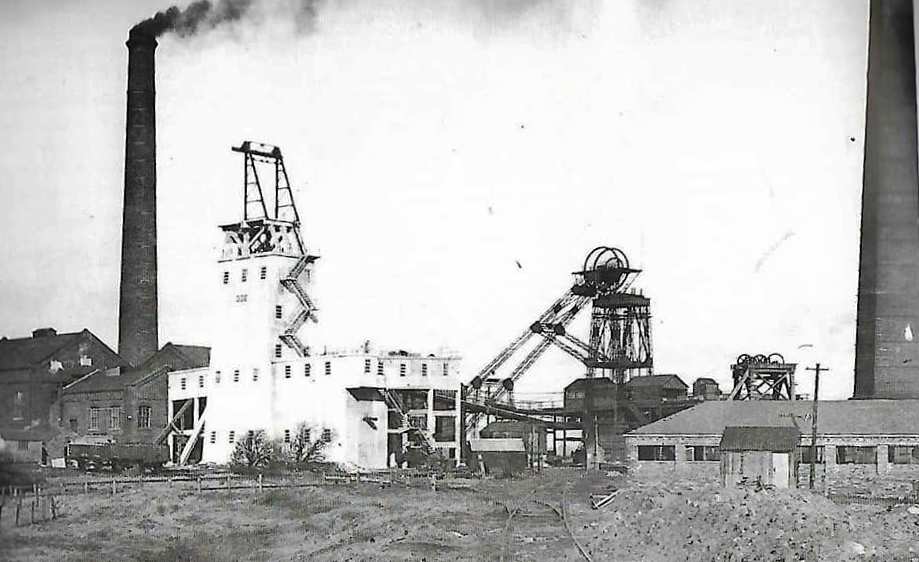The colliery is situated at Haydock. It is four miles from St. Helens, 7 from Wigan and 6 from Warrington. It is connected by rail on the north side to the Manchester/St. Helens line at Ashton-in-Makerfield and to the St. Helens mainline system at Broad Oak. On the south side of the colliery, a connection is made with the Wigan and Warrington and the Liverpool and Manchester lines of British Railways through a junction at Earlestown.
History of the Colliery
The colliery originally was one of a group owned by Richard Evans and Company. There were three shafts in use Nos. 1 and 2 being used for coal winding and No.3 shaft for pumping.
No.1 SHAFT (downcast) and was sunk 16 feet diameter in 1876 to 110 yards but owing to excessive water the sinking was stopped. In 1922 the shaft was widened to 18 feet to the Florida seam at 395 yards. It was again deepened in 1932 to the Trencherbone at 547 yards.
No. 2 SHAFT (Upcast) is 18 feet in diameter and sunk to the Florida seams in 1922 and deepened in 1932 to the Trencherbone.
No. 3 SHAFT is 16 feet in diameter and was sunk in 1876 to 125 yards and was abandoned for the same reason as No 1 shaft. It was used as a pumping shaft to deal with the water from the Permo-Triassic sandstone which overlies the coal measures.
Coal was first wound at the colliery in 1922 and at the present time coal winding level on No 1 shaft at the Florida level at a depth of 397 yards. In No.2 shaft coal is wound from two insets, the Crombuke and {SOME MISSING HERE} Both shafts are equipped with steam winders and two deck cages each deck three holding 12.3 cwt capacity tubs.
GEOLOGICAL FEATURES
The coalfield is bounded on the west by the Twenty acre Fault, which separates the field from the Bold Colliery and on the east by the Boston Fault which separates it from Wood Pit. On the northern boundary is the Red Rock fault running in an east-west direction. The field is subdivided by the Downall Green Fault and the Hazel Grove Fault. The workings in the area between the Twenty Acre and the Downall Green Faults reveal the existence of considerable minor faulting. The full dip of the seams id generally 1 in 4 to the south-east.
OUTPUT AND MANPOWER
The colliery at present employs 700 men and has an output of 890 tons per day with OMS of 23 cwt.
STEAM PLANT
There are 7 Lancashire boilers in use fired by hand and work at a pressure of 160 lb.. per sq. ins.
WINDERS
No 1 winder was made by Yates and Thom. It consists of a compound engine with cylinders of 33″ and 55″ and a 5-foot stroke. No 2 winder is a cylindrical compound engine constructed in 1917 by Worsley Mesnes. At the moment the cylinders are sleeved down to 32″ with a 6′ stroke.
VENTILATION
This is provided by a Walker Indestructible Centrifugal fan of the double inlet type and is driven by a 400 hp electric motor. The fan was designed for a duty of 400,000 cu. ft. per min at 52 water gauge when running at 136 rpm. The present duty fan is 330,000 cu ft per mine at 3.9″ water gauge at 117 rpm. It is at present operated on 70% efficiency.
AIR COMPRESSORS
A compressed air capacity of 10,450 cu. ft per min is obtained from two steam-driven compressors supplying 8,250 cu. ft and an electric driving machine supplying 2,200 cu. ft.
ELECTRIC POWER
The colliery used to generate its own electricity. the supply is now got from MANWEB at 2.200 v 3,000 KVA and the maximum demand is 1,950 kW.
COAL PREPARATION
The coal is now hauled from the shafts by endless rope haulage along a gantry for a distance of some 400 yards to the screens and washery which also serves Wood Pit. There are 7 picking belts with a capacity of 500 ton per hour. The coal is handpicked and the below 3″ size goes to the washery. The washery works on the Baum principle and has a rated capacity of 100 tons per hour.
The colliery closed in March 1964 and the men were transferred to Parkside colliery.
Colliery Profile From NCB No. 3 St. Helens Area. 1964.
A number of accidents and incidents have been recorded at the colliery. In 1930 a methane explosion claimed the lives of 13 men and a further 10 were injured. The full report can be found here.
Return to previous page

